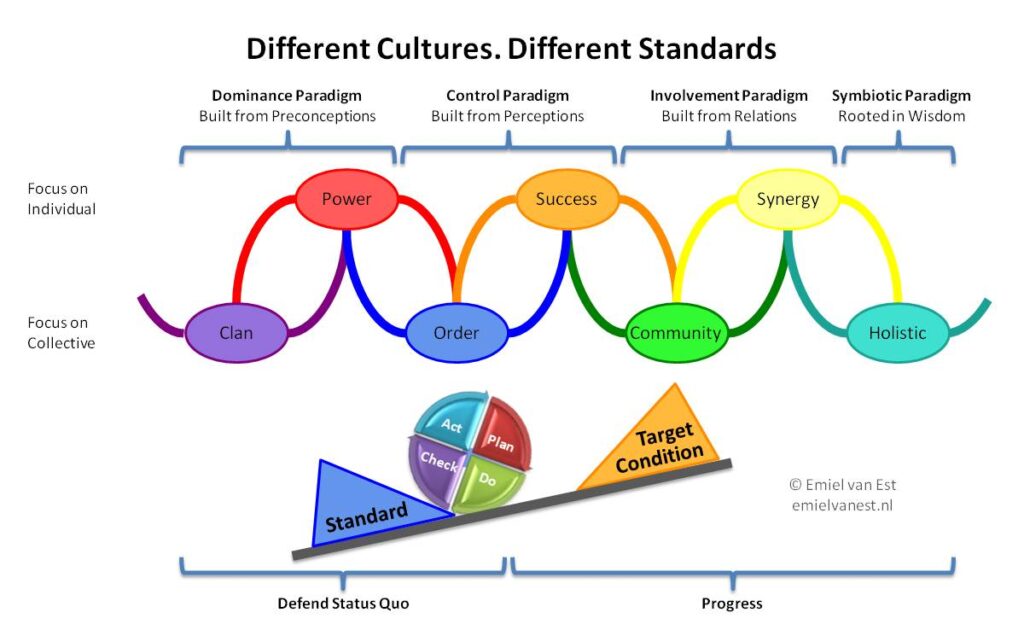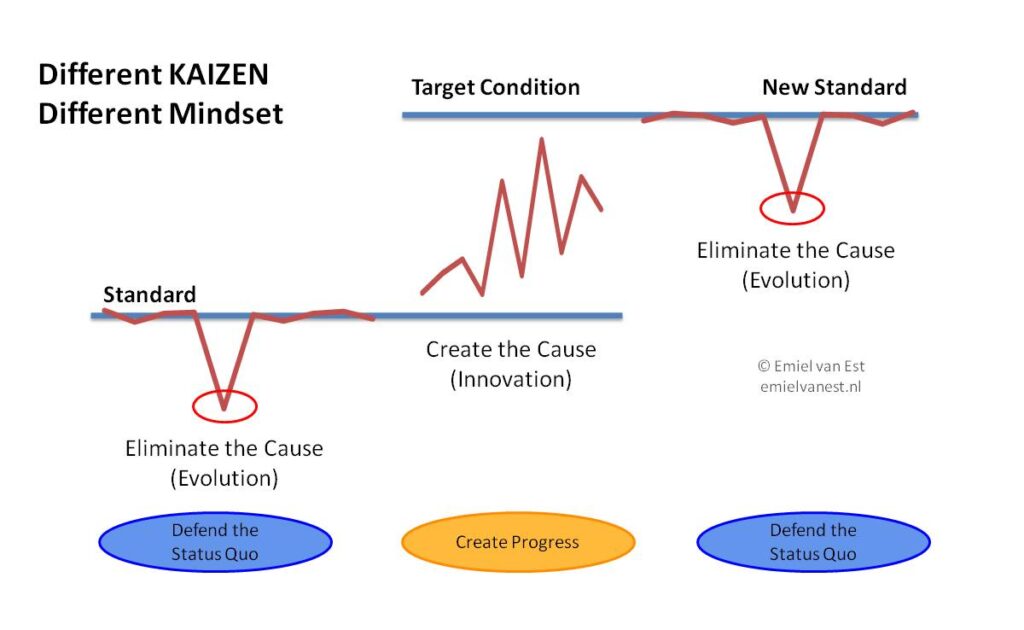I may have to apologize to many of my students and mentees…
Since 2011 I have been heavily influenced by Mike Rother’s slide deck called Let’s Retire the PDCA Wedge. Its message resonated a lot with me so I became a strong advocate and by doing so I brought about fierce discussion with fellow Lean enthusiasts.
This wedged standard looks like a model for standstill to me.
Message to my students and mentees for many years.
Standards & Spiral Dynamics
Only very recently I started to reconsider once I began mapping and matching my learnings about Lean and Continuous Improvement with the cultural development stages as described by Spiral Dynamics.

In the image above you see both a Standard and a Target Condition.
Now I think that the Standard as a Wedge, as heavily defended by my fellow Lean enthusiast, has its place in a specific developmental stage of a continuous improvement culture. I think that a Standard helps building a culture of BLUE Order.
The Target Condition, on the other hand, seems to have its place in another specific developmental stage of a continuous improvement culture. I think a Target Condition helps building an ORANGE Succes culture.
Both the BLUE Order Culture and the ORANGE Succes culture are in the Control Paradigm that leans heavily on the perception of facts and, therefore, on going to Genba. There are more similarities like the use of a reference, either a Standard or a Target Condition to help identify gaps and also the use of PDCA as a scientific way of experimenting is very similar.
Maybe that is why it was so hard to distinguish the one from the other. On the surface it all looks very similar. But if you look deeper you start to recognize that the use of a Standard aims to Defend a Status Quo while the use of a Target Condition aims to create Progress.
Two types of KAIZEN
Toyota explains Kaizen as:
Kaizen:
The Toyota Way 2001
We improve our business operations continuously, always driving for innovation and evolution.
So Toyota sees both innovation and evolution as Kaizen. From a cultural perspective these two types of Kaizen seem to be quite different though.
I associate the innovative kind of Kaizen with a ORANGE Succes culture where a Target Condition is used and I associate the evolutionary kind of Kaizen with a BLUE Order culture where a Standard is used.

The evolutionary kind of Kaizen is the most well known way of Kaizen and strives to keep performing according to a defined Standard.
Standard:
Best known method for producing a product or service.
Currently it may be possible to work, for example, 90% of the time according to the standard. During 10% of the time there may be a gap. By eliminating the causes of these gaps the performance may improve to, for example, 95% of the time according to standard. So, over time the performance improves in small steps, hence the evolutionary nature of this type of Kaizen.
The innovative kind of Kaizen may come as a surprise for many but as a Toyota Kata practitioner it makes perfect sense. In Toyota Kata terminology you try to reach a challenge by working on successive target conditions to achieve a level of performance in the (near) future that is currently not yet possible.
Target Condition:
My definition to contrast a Target Condition with a Standard
Better unknown method for producing a product or service.
So, currently it may be possible to work, for example, only 5% of the time according to the Target Condition, the rest of the time there is a (big) gap because of all kinds of obstacles that we need to overcome. We try to overcome these obstacles by causing a change, by creating innovative solutions.
Different mindsets
I hope the explanation above gives you an impression of the subtle differences in the way of operating depending on the kind of Kaizen we are practicing.
On the surface the actions look very similar but the intention feels very different.
Defending a Status Quo feels very different from Creating Progress.
Eliminating causes feels very different from causing a change.
Also the thinking processes are slightly different.
Defending a Status Quo requires the thinking of a crime scene investigator.
Eliminating causes requires the thinking of a crime scene investigator.
Creating Progress requires the thinking of a creative solutions inventor.
Causing a change requires the thinking of a creative solutions inventor.
By now we almost completed the BTFA framework develloped by David Bovis. We have got the thinking, feeling and acting part of the model. So what about the belief part of the BTFA model?
Is the belief system of a crime scene investigator the same as the one of a creative solution inventor? What is their respective definition of good?
The belief system that fuels Defending a Status Quo is quite different than a belief system than fuels Creating Progress.
The belief system that drives to eliminate the cause of a change is quite different than a belief system that aims to cause a change.
What do you believe?
What do you think?
What do you feel?
How do you act?
Are you more a crime scene investigator or a creative solutions inventor?
PS
No good or bad here, both are needed to create a coherent culture of Continuous Improvement.